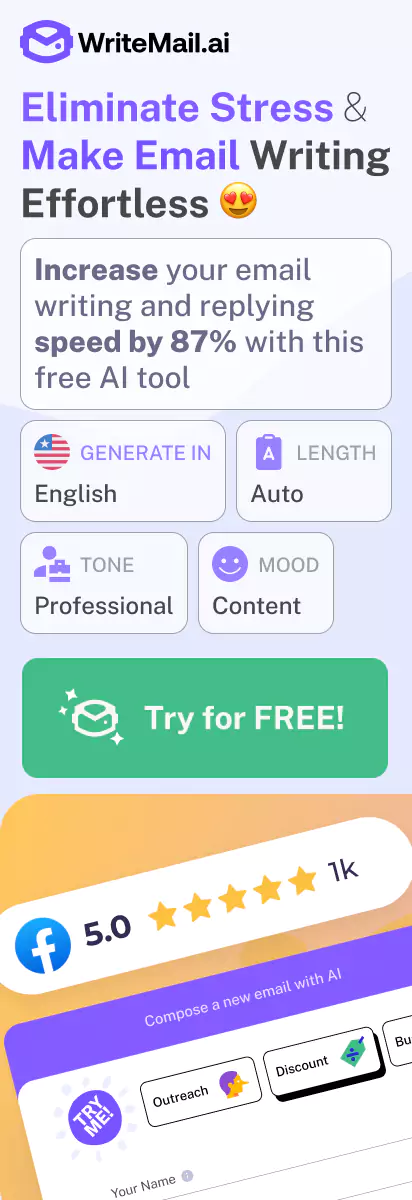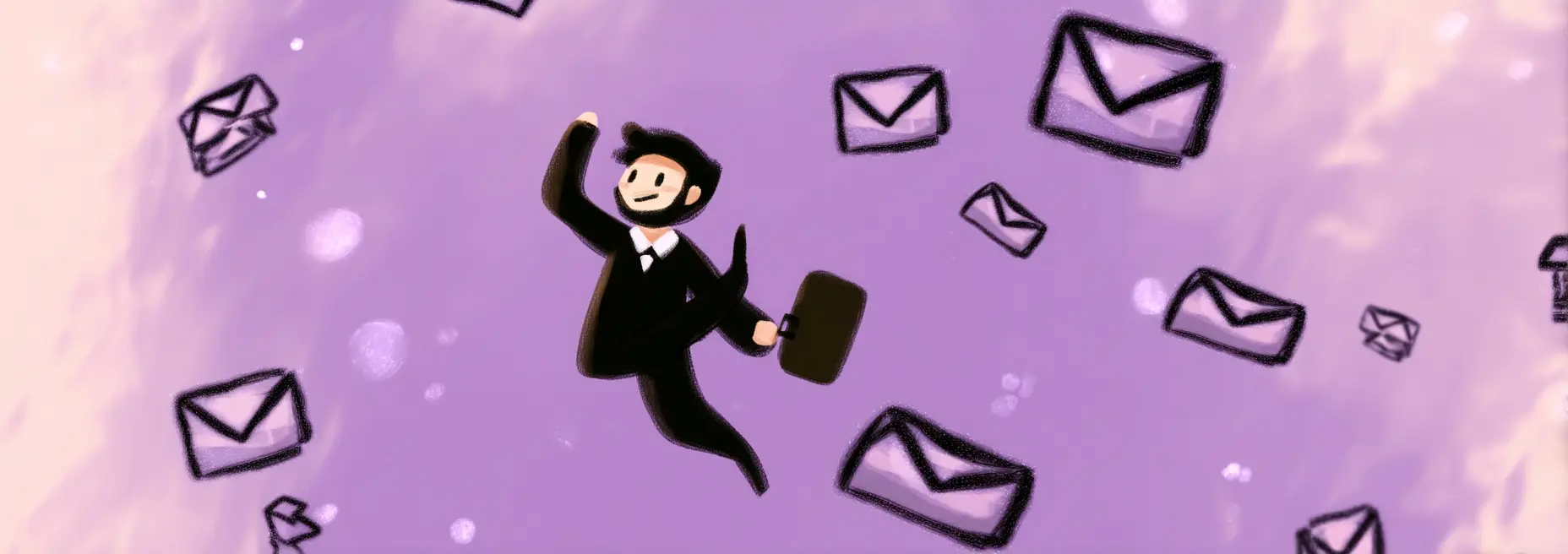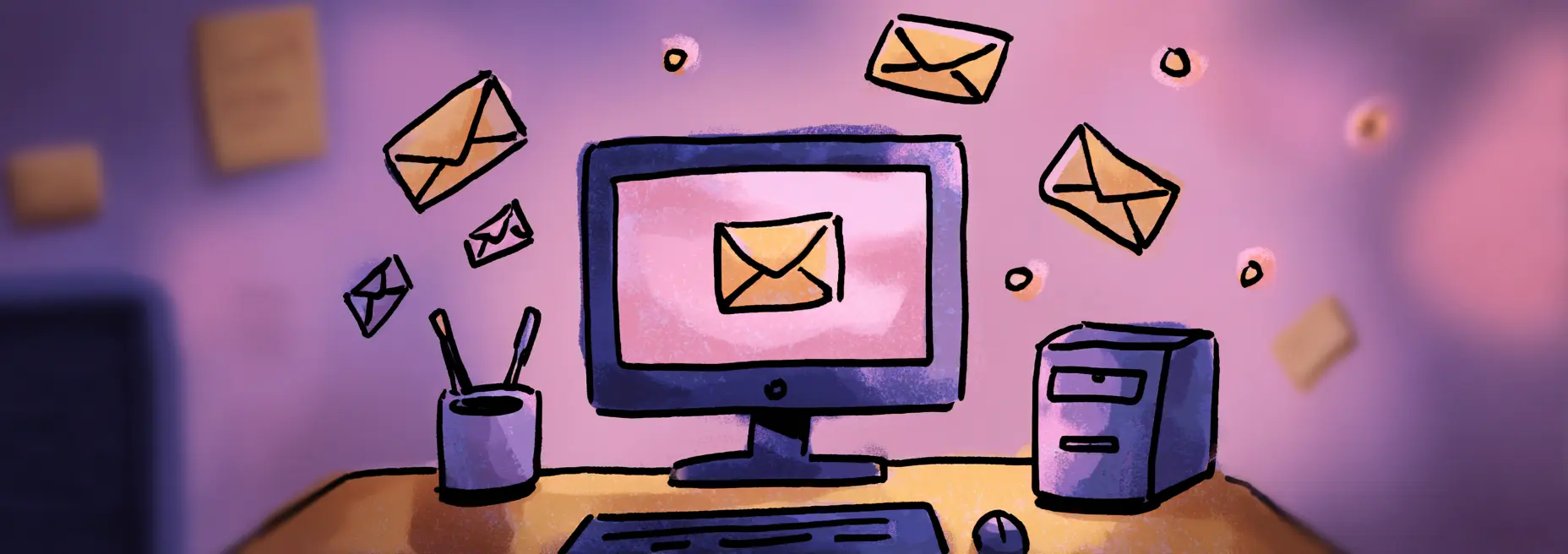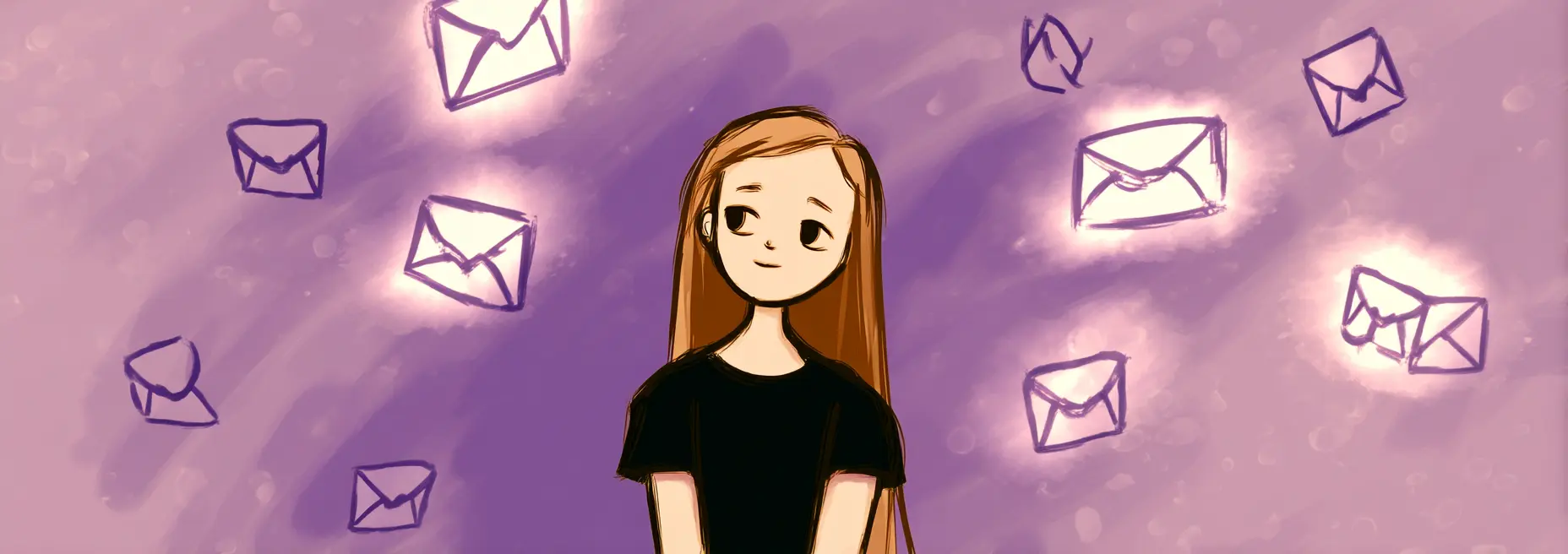Staring at that blank email template, cursor blinking expectantly while you try to craft the perfect message to a potential employer? You’re not alone. I’ve been there too – agonizing over every word, wondering if my cold email will ever get read, let alone responded to.
Here’s a sobering reality: the average professional receives 121 emails per day, and hiring managers often see double that number. Your cold email is competing with dozens of others for attention in an already overflowing inbox. But don’t be discouraged – I’m about to show you how to stand out.
When you write a cold email for a job opportunity, you’re not just sending a message – you’re creating a first impression that could change your career trajectory. I’ve helped hundreds of job seekers refine this crucial skill, and I’ve seen firsthand how the right approach can open doors that seemed firmly shut.
According to a recent survey by TopResume, 35% of hiring professionals admit they’ve hired someone based on an impressive cold outreach email. This means your thoughtfully crafted message really can make the difference between being ignored and landing an interview.
In this guide, you’ll discover exactly how to write cold emails that get responses. I’ll share the proven formula that has helped my clients secure interviews at competitive companies, including templates you can customize for your own job search. You’ll learn how to research effectively, craft compelling subject lines, and create personalized messages that showcase your value while respecting the recipient’s time.
Whether you’re reaching out to a dream employer, connecting with a hiring manager, or following up after submitting an application, these strategies will help you write cold emails that actually work. Let’s start by examining the crucial elements every successful cold email must include…
Research: The Foundation of an Effective Job Cold Email
Before you write a single word of your cold email, you need to do your homework. I can’t stress this enough – research is what separates forgettable cold emails from the ones that actually land interviews. When you take the time to understand who you’re writing to and why they should care about you, your email transforms from generic to compelling.
How to Thoroughly Research the Company
When you’re targeting a specific organization, surface-level knowledge won’t cut it. You need to dig deeper to demonstrate genuine interest and find unique connection points.
Essential company research areas:
- Company culture and values – Review their website’s “About Us” page, mission statement, and employee testimonials on Glassdoor to understand what they truly care about
- Recent news and developments – Check their press releases, blog posts, and social media accounts to identify recent achievements, challenges, or changes
- Pain points and challenges – Look for interviews with executives or industry analyses that reveal what problems the company is trying to solve
- Growth trajectory – Research whether they’re expanding, pivoting, or consolidating to understand their current priorities
- Competitors – Understand their competitive landscape to better articulate how you might help them gain an edge
I recommend creating a simple document where you can collect these insights. When you write your cold email, you’ll have specific points to reference that show you understand their world – not just that you want a job.
Techniques for Finding the Right Recipient
Sending your email to the wrong person – or worse, a generic inbox – dramatically reduces your chances of success. Your goal is to reach the actual decision-maker who has hiring authority for your target role.
Strategies to identify the right contact:
- Use LinkedIn to find the department head or hiring manager for your desired position
- Check the company’s “Team” or “About Us” page for organizational structure insights
- Review recent job postings to identify who the role reports to
- Use tools like Hunter.io, Clearbit Connect, or RocketReach to find verified email addresses
- If you’re uncertain about the exact person, aim for someone 1-2 levels above the position you want
When you’ve identified your target contact, I suggest verifying their email format. Most companies follow predictable patterns ([email protected] or [email protected]). You can confirm the format by finding other employee emails or using email verification tools.
Strategies for Understanding the Recipient’s Background
The more you know about the person you’re emailing, the more effectively you can connect with them. This personalized research helps you speak their language and reference topics they care about.
Key areas to research about your recipient:
- Professional background – Review their LinkedIn profile to understand their career path and how long they’ve been at the company
- Content they’ve created – Read their articles, blog posts, or presentations to understand their thinking
- Social media presence – Check their Twitter or other public profiles for professional interests and communication style
- Shared connections – Identify mutual contacts who might provide insights or even an introduction
- Recent accomplishments – Look for interviews, quotes in press releases, or conference presentations they’ve given
This research isn’t just about finding facts – it’s about understanding their perspective. What challenges are they likely facing in their role? What priorities might be top of mind? When you can frame your experience in terms of their needs, your email becomes immediately more relevant.
Example: Turning Research into Personalized Content
Notice how this example doesn’t just name-drop the interview but specifically references a challenge mentioned in it. The sender then connects their experience directly to that challenge, showing they’ve done their homework and have relevant expertise to offer.
Using AI Tools to Organize Research Insights
When you’re conducting extensive research on multiple companies and contacts, staying organized becomes crucial. WriteMail.ai and similar tools can help you efficiently extract and organize key insights from your research data.
These tools allow you to:
- Create company and contact profiles with relevant details
- Extract key themes and priorities from company materials
- Identify optimal personalization points based on your research
- Store templates with customization options for different industries
Remember, research isn’t just a preliminary step – it’s the foundation that makes everything else in your cold email effective. When you take the time to truly understand who you’re writing to and what matters to them, you dramatically increase your chances of getting a response.
In my experience, spending at least 30 minutes researching before writing can make the difference between an email that gets deleted and one that leads to a conversation. The insights you gather will inform every other element of your email, from the subject line to your call-to-action.
Crafting an Attention-Grabbing Subject Line
I can’t overstate how crucial your subject line is when sending cold emails for job opportunities. Think of it as the gateway to your entire application – if it doesn’t compel the recipient to click, all your carefully crafted content inside will never see the light of day.
The Psychology Behind High-Performing Subject Lines
Research consistently shows that personalized subject lines increase open rates by an impressive 26%. This makes perfect sense when you consider how overwhelmed hiring managers are with generic applications. When you tailor your subject line specifically to the recipient or company, you’re immediately signaling that this isn’t just another mass-sent application.
Your subject line needs to accomplish several things simultaneously:
- Grab attention without resorting to gimmicks
- Convey relevance to the recipient’s needs
- Create enough curiosity to warrant an open
- Avoid spam triggers that might filter out your message
Winning Formulas for Job-Focused Subject Lines
When crafting your subject line, I recommend structuring it around one of these proven approaches:
Value Proposition Formula
- Focus on what you bring to the table
- Highlight a specific, relevant skill or achievement
- Example: “Senior Developer with 5+ years in AI implementation”
Mutual Connection Reference
- Mention a shared connection to establish instant credibility
- Only use when you have a genuine connection
- Example: “Referred by Jane Smith – Marketing Specialist Position”
Research-Based Personalization
- Reference a recent company achievement or challenge
- Demonstrate you’ve done your homework
- Example: “Ideas for scaling your customer success team after your Series B”
Direct Problem-Solution Approach
- Identify a potential need and position yourself as the solution
- Keep it specific and achievement-focused
- Example: “How I increased conversion rates 32% for companies like yours”
Specific Role Interest
- Clearly state the position with a personal touch
- Add a qualifying detail about yourself
- Example: “Experienced Project Manager interested in your Sustainability Initiative”
Subject Line Mistakes That Kill Your Chances
While focusing on what works, you should also be aware of what can send your email straight to the trash folder:
- ALL CAPS or excessive punctuation!!! – These appear unprofessional and trigger spam filters
- Vague or generic subjects – “Job application” or “Interested in working for you” won’t stand out
- False promises or clickbait – Starting off with deception destroys trust immediately
- Lengthy subject lines – Keep it under 50 characters to ensure it displays properly on mobile devices
- Spelling or grammar errors – These signal carelessness and a lack of attention to detail
5 Effective Subject Line Examples with Explanations
1. Marketing expertise that drove 43% growth at Spotify
Why it works: This subject line quantifies your impact at a recognizable company, immediately establishing credibility and relevance. The specific percentage adds authenticity.
2. Following your TechCrunch interview – UX Designer with fintech focus
Why it works: Referencing a specific interview or article shows you’ve researched the recipient while clearly stating your relevant specialization.
3. Sarah Miller suggested I contact you about your data science opening
Why it works: Leading with a mutual connection creates instant trust and provides context for why you’re reaching out.
4. 3 ideas to improve your customer retention (from your newest team member?)
Why it works: This offers immediate value while creating curiosity with the parenthetical suggestion that implies confidence without arrogance.
5. Quick question about your expanding product team at Acme
Why it works: The “quick question” format feels low-commitment and conversational, while showing company-specific knowledge. Most people are naturally curious about questions directed to them.
Optimizing Subject Lines for Different Industries and Roles
What works for a creative role might fall flat for a financial position. When tailoring your subject line, consider the industry culture:
- Tech/Startups: Embrace innovation and direct problem-solving approaches
- Finance/Legal: Opt for more formal, credentials-focused subject lines
- Creative Fields: You can be more conversational and showcase your unique voice
- Healthcare/Education: Emphasize relevant specialized knowledge and mission alignment
I’ve found that testing multiple versions of your subject line before sending can dramatically improve your success rate. You might consider using AI tools like WriteMail.ai to generate and test variations optimized for your specific industry and role. This can help you identify which approach is most likely to resonate with your particular recipient.
Remember, your subject line is your first impression—make it count by being specific, relevant, and genuinely interesting to the person on the receiving end. In the next section, I’ll show you how to structure the body of your email to deliver on the promise your subject line makes.
Structuring Your Cold Email for Maximum Impact
When you’re sending a cold email for a job, you have mere seconds to make an impression. I’ve found that the structure of your email can make or break your chances of getting a response. Let’s break down exactly how you should organize your cold email to maximize its impact.
The Critical First Paragraph: Establishing Relevance in Under 3 Seconds
Your opening paragraph needs to answer one crucial question immediately: “Why should I care?” Hiring managers and recruiters receive hundreds of emails daily, so you need to establish relevance right away.
I recommend starting with a personalized hook that demonstrates you’ve done your homework. For example:
- Reference a recent company achievement: “I was impressed by your team’s recent launch of [specific project]…”
- Mention a mutual connection: “After speaking with [name] from your marketing department about your commitment to data-driven campaigns…”
- Comment on a specific company challenge: “I noticed your recent expansion into the European market and the unique compliance challenges this presents…”
The key is specificity. Generic openings like “I found your company online and am interested in opportunities” will send your email straight to the trash folder.
How to Clearly Communicate Your Value Proposition to the Employer
After hooking them with relevance, you need to immediately pivot to your value proposition. This is where you connect the dots between what they need and what you can offer.
When you write this section, remember the formula: Problem + Your Solution + Proven Result.
For example, instead of saying “I have five years of experience in digital marketing,” try: “In my five years leading digital campaigns at XYZ Corp, I increased conversion rates by 34% by implementing multi-channel attribution models—the same challenge I noticed your team mentioned in your recent industry panel.”
This approach shows you understand their specific needs and have concrete evidence of solving similar problems.
Balancing Confidence with Humility in Your Approach
When I coach professionals on cold email writing, I often see them swing to extremes—either coming across as arrogant (“I’m the best candidate you’ll find”) or too self-deprecating (“I know you probably have better candidates”).
The sweet spot is confident humility. Share your accomplishments matter-of-factly without exaggeration, and express genuine excitement about the possibility of contributing to their team.
Try phrases like:
- “I’d be excited to share how my experience in X could support your goals in Y…”
- “While I’ve had success implementing these strategies at my current company, I’m particularly interested in the unique challenges in your industry…”
This balance shows you’re both competent and coachable — a combination most hiring managers find irresistible.
Example of a Well-Structured Cold Email
What makes this email effective:
- The first paragraph immediately establishes relevance by referencing the recipient’s own content
- The second paragraph clearly states the value proposition with specific, quantified results
- The bullet points offer tangible ideas, demonstrating both expertise and initiative
- The email length is concise (under 200 words) while still conveying complete thoughts
- The call-to-action is specific and low-friction, offering exact times for a brief conversation
Strategic Use of Formatting to Make Key Information Stand Out
When you structure your cold email, remember that most recipients will scan it before deciding whether to read it fully. Strategic formatting can help guide their eyes to the most important information.
I recommend using these formatting techniques:
- Short paragraphs – Limit each paragraph to 2-3 sentences maximum
- Strategic bolding – Highlight 1-2 key phrases that communicate core value, but don’t overdo it
- Bullet points – Use for listing skills, accomplishments, or ideas to improve scanability
- White space – Include breathing room between paragraphs for easier reading
However, you should avoid these common formatting errors:
- Multiple fonts or colors (appears unprofessional and may trigger spam filters)
- ALL CAPS sections (comes across as shouting)
- Excessive bold, italics, or underlining (dilutes emphasis)
- Lengthy paragraphs without breaks (creates a text wall that discourages reading)
The perfect cold email structure follows what I call the “5-3-1 Rule”: it should take 5 seconds to scan, 3 key points should stand out visually, and there should be 1 clear action request at the end.
When you master the structure of your cold email, you dramatically increase your chances of standing out in a crowded inbox. The combination of a compelling opening, clear value proposition, and strategic formatting creates a professional impression that makes hiring managers more likely to respond — even when they weren’t actively looking to fill a position.
Remember that your email structure should create a natural flow that leads the reader from curiosity to interest to action. In the next section, we’ll dive deeper into how to personalize this structure to create an instant connection with the recipient.
Personalizing Your Message to Stand Out
Let’s face it — hiring managers receive dozens, if not hundreds, of cold emails from job seekers every week. When you’re competing against so many other candidates, personalization isn’t just a nice touch—it’s absolutely essential for getting noticed. I’ve seen countless generic emails get instantly deleted, while thoughtfully personalized messages land interviews at competitive companies.
Methods for Demonstrating Genuine Interest
When you’re reaching out cold, you need to quickly establish that you’re not just mass-emailing every company in your industry. Here’s how you can show genuine interest that captures attention:
- Reference recent company news: “I was impressed by your recent partnership with Tesla to develop sustainable battery technology, especially since environmental engineering has been my focus for the past five years.”
- Mention specific projects: “Your team’s work on the cloud migration project highlighted in last month’s Tech Review aligns perfectly with my experience leading similar transitions at Oracle.”
- Connect with company values: “Your commitment to diversity and inclusion resonates strongly with me—I’ve led DEI initiatives at my current company that increased representation by 32% over two years.”
- Show product knowledge: “I’ve been an active user of your CRM platform since 2020, and I’ve always been impressed by the intuitive UI—something I’d love to contribute to as part of your design team.”
The key is specificity. Generic statements like “I love your company culture” or “I’m passionate about your industry” immediately signal to the recipient that you haven’t done your homework.
How to Mention Relevant Accomplishments Without Sounding Boastful
You need to highlight your achievements, but there’s a fine line between confidence and arrogance. I recommend these approaches:
- Frame accomplishments as solutions: Instead of “I increased sales by 45%,” try “When faced with declining quarterly revenue, I implemented a strategy that reversed the trend and delivered a 45% growth over six months.”
- Connect your wins to their needs: “Your job posting mentions the need for improving operational efficiency—in my current role, I’ve reduced processing times by 30% through workflow automation that could be adapted to your environment.”
- Let metrics do the talking: Raw numbers often feel less boastful than qualitative claims. “Managed a portfolio of $3.2M” sounds more factual than “Successfully managed a massive portfolio.”
- Use “we” when appropriate: “Our team delivered the project 2 weeks ahead of schedule, where I was responsible for the database architecture and deployment strategy.”
Remember, the goal isn’t to downplay your achievements but to present them in a way that feels relevant and helpful rather than self-congratulatory.
Techniques for Creating an “Instant Connection” with the Recipient
Human connection can be your secret weapon in cold emails. Here’s how you can quickly establish rapport:
- Find mutual connections: “I noticed we’re both connected to Sarah Johnson, who spoke highly of your leadership approach during our collaboration at the Chicago Tech Summit.”
- Reference shared experiences: “As a fellow Northwestern alumnus, I’ve followed your career path with interest since your interview in the alumni newsletter.”
- Mention shared interests: “I noticed from your LinkedIn that you’re also passionate about mountain biking—I just completed the Colorado Trail last summer.”
- Acknowledge their expertise: “Your presentation on sustainable supply chains at last year’s Green Business Conference changed my perspective on inventory management—I’ve since implemented several of your suggestions.”
Important note: Only mention personal details that are professionally accessible (like information from LinkedIn or public speaking engagements). Anything that feels like you’ve been digging too deeply into their personal life will come across as intrusive rather than connective.
Example: Before and After Personalization
Generic vs. Personalized Marketing Manager Application
BEFORE (Generic):
AFTER (Personalized):
Notice how the personalized version demonstrates specific knowledge about the company, connects the sender’s experience directly to the company’s current initiatives, references a potential shared connection, and makes the value proposition crystal clear.
Matching Tone with Company Culture While Maintaining Authenticity
Different companies have different communication styles, and you’ll stand out when you can match their tone while still sounding like yourself. Here’s how I approach this balance:
- Study their content: Review their website, social media, job descriptions, and employee LinkedIn posts to get a feel for their communication style. Is it formal or casual? Do they use industry jargon or plain language? Do they incorporate humor?
- Adjust your formality level: A law firm or financial institution may warrant more formal language, while a tech startup might respond better to a conversational approach.
- Mirror key phrases: If they talk about “delighting customers” rather than “customer satisfaction,” incorporate their terminology naturally.
- Maintain your voice: While adapting to their style, ensure your unique perspective and personality still shine through. If you’re naturally enthusiastic, don’t suddenly become overly formal just because the company seems corporate.
Using WriteMail.ai’s tone adjustment features can help you find this balance, with customizable settings that adapt your natural writing style to match different corporate cultures without losing your authentic voice.
Remember, personalization isn’t just a tactical approach—it demonstrates your attention to detail, research abilities, and genuine interest in the specific role. These qualities immediately set you apart from the majority of job seekers who rely on templates and generic language. When you show that you’ve invested time in understanding the company and recipient before asking for their time, you’re already demonstrating the kind of initiative and thoughtfulness that makes for an exceptional employee.
Call-to-Action and Follow-up Strategy
After you’ve captured your recipient’s attention with personalization and demonstrated your value, you need to close with a clear next step. The way you end your cold email can make the difference between getting a response or being ignored. Let me show you how to craft CTAs that make it easy for hiring managers to say “yes” and follow up effectively when they don’t.
Creating a Clear, Low-Friction Call-to-Action
The best CTAs feel like an obvious next step rather than a big commitment. When I review cold emails, I often see candidates asking for too much too soon (“Can I interview for the position?”) or being too vague (“I’d love to connect”).
Elements of an effective CTA:
- Be specific about what you’re asking for – A 15-minute phone call? A brief video chat? Coffee meeting?
- Explain the benefit to them – What will they gain from connecting with you?
- Make responding simple – Reduce the mental effort required to say yes
- Sound confident but not entitled – Show you value their time
I’ve found that providing a clear, time-bound request works best. For example: “Would you be open to a 15-minute call next Tuesday or Wednesday to discuss how my experience in data visualization might benefit your analytics team?”
The Art of Suggesting Specific Times/Formats
When you suggest specific times or formats for connecting, you remove decision fatigue for the hiring manager. Think about it – if you ask “When are you free to chat?” you’re asking them to check their calendar and make decisions. Instead, give them options they can simply say “yes” to.
Effective time/format suggestions:
- Offer 2-3 specific date/time options: “Would Tuesday at 2pm or Wednesday at 10am work better for you?”
- Suggest multiple formats: “I’m happy to connect via phone, Zoom, or even over coffee if you prefer”
- Include your availability upfront: “I’m generally available weekdays between 11am-4pm ET”
- Make it easy to schedule: “Feel free to book a time directly on my calendar: [link]” (if you use scheduling software)
Remember, you want to make it as effortless as possible for them to say yes while still respecting their schedule.
Research-Backed Timing Strategies for Follow-up Emails
Not hearing back after your initial email is normal, not a rejection. Studies show follow-ups sent 3-5 days later increase response rates by 25%. The key is being persistent without becoming annoying.
Follow-up timing best practices:
- First follow-up: Send 3-5 business days after your initial email
- Second follow-up: Send 5-7 business days after your first follow-up
- Third follow-up: Send 7-10 business days after your second follow-up
- Final outreach: Send 2-3 weeks after your third follow-up
I’ve found that varying your contact method can also increase your chances of a response. If email isn’t working after 2-3 attempts, consider a polite LinkedIn message that references your emails.
Initial Cold Email Example with Follow-up Sequence
Follow-up #1 (Sent 4 days later)
Follow-up #2 (Sent 6 days later)
Notice how each follow-up adds new value, references the previous outreach, and maintains a respectful, non-pushy tone. The sequence shows persistence while demonstrating an understanding of the recipient’s priorities.
How to Use AI to Schedule and Optimize Your Follow-up Email Timing
Managing multiple job search cold emails and their follow-ups can quickly become overwhelming. This is where AI tools can significantly streamline your process. WriteMail.ai can help you craft tailored follow-up emails that maintain the right tone and add new value with each contact.
AI-assisted follow-up strategies:
- Set up automatic reminders for when to send each follow-up
- Track which emails have been opened to prioritize your follow-ups
- Analyze which days and times get the best response rates for your target industry
- Test different follow-up approaches and measure their effectiveness
- Generate variations of your follow-up that add new information while maintaining consistency
The key to successful follow-ups is balancing persistence with respect. You want to demonstrate your genuine interest in the role without coming across as desperate or entitled. With each follow-up, add a new piece of information or insight that provides value to the recipient, giving them a fresh reason to respond.
Remember, your follow-up strategy reflects your professional communication style. If you’re thorough, respectful, and value-focused in your follow-ups, hiring managers will notice and appreciate these qualities—even if they don’t have an immediate opportunity for you.
Testing, Measuring, and Improving Your Cold Email Approach
Sending cold emails for job opportunities isn’t just about crafting one perfect message and hoping for the best. I’ve found that the most successful job seekers treat cold emailing as an evolving process that improves over time. Think of it as developing your own personal marketing campaign—you need to track what works, learn from what doesn’t, and continuously refine your approach.
Tracking Key Performance Metrics
When you’re sending cold emails for job opportunities, you should be monitoring these crucial metrics to gauge effectiveness:
- Open rates: If your emails aren’t being opened, nothing else matters. An open rate below 15-20% suggests your subject lines need improvement.
- Response rates: This is the percentage of emails that receive any reply. Even a “not interested” response provides valuable data.
- Meeting conversion rate: How many responses actually convert to interviews or calls? This measures the effectiveness of your call-to-action.
- Time-to-response: How quickly are people responding? Faster responses often indicate stronger interest or more compelling messages.
I recommend creating a simple spreadsheet where you track these metrics for each email template or approach you try. This data will become incredibly valuable as you refine your strategy.
A/B Testing Strategies for Job Search Cold Emails
To systematically improve your cold emails, you’ll want to implement A/B testing — where you change just one element at a time to see what performs better. Here’s how you can approach this:
What to Test:
- Subject lines: Test different approaches (question-based vs. statement-based, mentioning specific skills vs. company achievements).
- Opening paragraphs: Compare different hooks—industry observation vs. company-specific insight vs. mutual connection.
- Value proposition: Test different ways of articulating what you bring to the table.
- Call-to-action: Compare specific meeting requests vs. open-ended questions.
- Email length: Test concise (150 words) vs. slightly more detailed (250 words) approaches.
When you’re conducting these tests, be sure to only change one variable at a time and send each version to a similar group of recipients. Otherwise, you won’t know which change caused the difference in results.
Remember: The goal of testing isn’t to find a universal “perfect email” but to discover what works best for your specific skills, target industry, and the types of roles you’re pursuing.
Adapting Based on Feedback and Results
As you collect responses (or non-responses), you’ll gather valuable insights to improve your approach:
- Direct feedback: When someone responds with specific comments about your email, take those suggestions seriously.
- Pattern recognition: Look for commonalities among the emails that received positive responses. Was there a particular subject line formula that worked better? A certain length or tone?
- Industry-specific insights: You might discover that different approaches work better in different industries—tech companies might prefer concise, direct emails while creative agencies might respond better to more personality-driven messages.
I’ve found that taking notes after each response can help you identify these patterns. Jot down what seemed to work and what didn’t immediately after receiving a reply.
Example of a Cold Email Evolution Through Testing
Original Version (12% response rate)
Iteration #1 (18% response rate) – Improved subject line and opening
Iteration #2 (27% response rate) – Added specific value proposition and clearer CTA
As you can see in this evolution, each iteration incorporated specific improvements based on performance data and recipient feedback. The final version is significantly more personalized, value-focused, and includes a clearer, lower-friction call-to-action.
Using Analytics to Identify Success Patterns
As you collect more data through your testing efforts, you’ll start to notice patterns in your successful emails. You might discover that:
- Emails sent on Tuesday mornings get higher response rates
- Subject lines that mention specific projects outperform general skill-based ones
- Including 2-3 bullet points of achievements significantly improves conversion
- Suggesting specific meeting times doubles the likelihood of scheduling a call
Tools like WriteMail.ai can help you analyze your email performance data to identify these patterns, allowing you to replicate successful elements in future outreach efforts. By studying what resonates with your target employers, you’ll continuously improve your approach.
Creating a Feedback Loop
To truly optimize your cold email strategy, I recommend establishing a continuous improvement cycle:
- Send initial batch of emails using your best current approach
- Record performance metrics for each variation
- Gather direct and indirect feedback
- Identify what worked and what didn’t
- Implement changes in your next batch
- Repeat the process
Over time, this systematic approach will significantly improve your response rates and interview conversions. I’ve seen job seekers double or even triple their effectiveness by diligently applying these testing principles.
Remember that cold emailing for jobs is as much science as art. By measuring your results, testing methodically, and continuously refining your approach, you’ll develop a powerful skill that will serve you throughout your career—not just in landing your next position, but in any situation where persuasive communication matters.
Conclusion: Turning Cold Emails into Job Opportunities
When you’re navigating today’s competitive job market, mastering the art of cold email outreach can truly set you apart from other candidates. Throughout this article, I’ve shared strategies that can transform your cold emails from deleted afterthoughts to conversation starters with hiring managers and potential employers.
Remember, your cold email success depends on several key elements working together:
- Thorough company and recipient research that shows in your personalized content
- An attention-grabbing subject line that compels the recipient to open your message
- A well-structured email that quickly establishes relevance and communicates your value
- Personalization that demonstrates genuine interest and creates connection
- A clear, actionable next step that makes it easy for the recipient to respond
- Strategic follow-up that demonstrates persistence without being pushy
- Continuous improvement through testing and measuring your results
One final tip I’d like to share with you: when you’re crafting your cold emails, focus on how you can solve problems for the employer rather than just highlighting your qualifications. This subtle shift in perspective—from “here’s why I’m great” to “here’s how I can help you”—can dramatically increase your response rates.
If you find yourself spending too much time perfecting these emails, consider using WriteMail.ai to streamline the process while maintaining the personalization and quality that makes cold emails effective.
I encourage you to implement these techniques in your very next cold email. Start with just one position you’re truly excited about, apply these principles thoughtfully, and see the difference it makes. Even if you don’t get an immediate job offer, you’ll likely receive valuable feedback and begin building professional relationships that could lead to opportunities down the road.
Cold emailing for jobs isn’t just about landing an interview—it’s about demonstrating your communication skills, initiative, and professionalism before you ever walk through the door. With practice and persistence, you’ll find that these seemingly small messages can open surprisingly big doors in your career journey.










